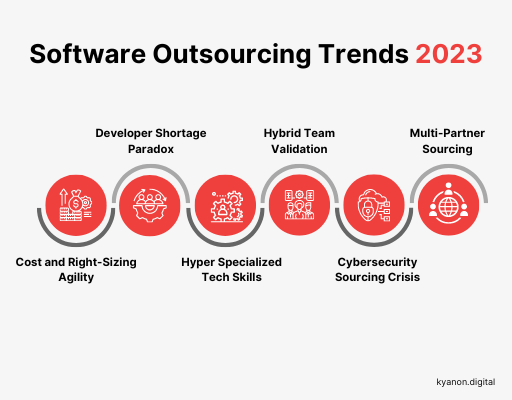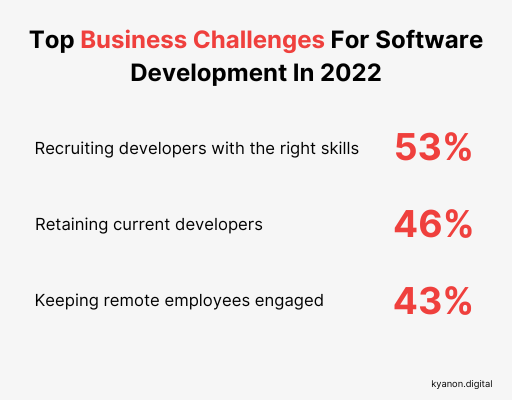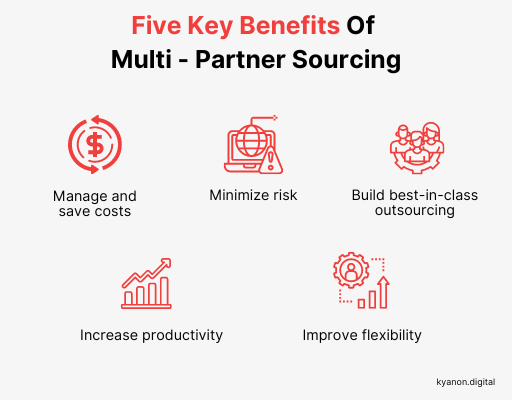Being an IT executive is never simple, but the last few years have been especially difficult. Having a strategic viewpoint is beneficial as we look ahead. Some patterns continue, others increase, and some emerge. All of these factors, however, must be considered for a future-proof plan.
Thanks to Accelerance’s worldwide network of hundreds of companies in 30+ nations, their valued advisers have a direct line into software outsourcing business trends. Here are their top choices for the high-impact software outsourcing trends that will influence software development outsourcing in 2023, according to their experts.

1. Cost and Right-Sizing Agility
Prior to 2020, software development outsourcing was shifting from a focus on efficiency to driving innovation. However, due to the pandemic, economic instability, and tech industry cutbacks, the situation changed. Now, IT leaders are prioritizing cost reduction and adapting to changing resource needs. Outsourcing provides the necessary control in the face of significant business uncertainty. Therefore, outsourcing has reverted to its origins as a means of cost savings and flexibility. This trend has persisted since the pandemic, according to Deloitte consulting. A recent study by BCG found that 89% of companies plan to reinforce their relationships with IT service providers. Software outsourcing has demonstrated its value in managing agility during economic cycles, corporate uncertainty, and budget cuts.
Outsourcing is beneficial in several ways, including:
- Reducing development costs by 40% to 70%, giving businesses more control over their budget and expenses.
- It also provides access to specialist skills necessary for technology projects and allows for flexibility in adjusting headcount through staff augmentation and managed project outsourcing.
- Additionally, outsourcing enables businesses to find affordable tech talent to drive digital transformation efforts.
According to reports from Accelerance, their customers are adjusting their corporate priorities in line with the prevailing economic conditions, scaling back some projects while accelerating others, and outsourcing allows for this rebalancing.
“Outsourcing levels are growing as more organizations take advantage of the cost flexibility that service providers offer.” – Computer Economics IT Outsourcing Statistics 2022
2. Developer Shortage Paradox
Layoffs at high-profile tech companies are generating news. Even so, “software developer” remains at the top of the list of the world’s most in-demand jobs, with one of the greatest change rates of any job category. Despite the fact that the tech industry is contracting, tech-led businesses are still scrambling to find qualified software engineers to create apps, migrate data, and adopt new technologies. At least half of CIOs say a dearth of qualified personnel makes it challenging for their businesses to expand and compete. It’s no wonder, then, that one of the top business obstacles for IT executives is finding and retaining skilled developers. The software development staff is suffering as a result of the time-consuming and costly recruiting procedure.
Outsourcing software development can directly address these issues by:
- Halting the downward cycle of recruitment and retention by providing access to highly qualified developers in places where labor constraints are less severe.
- Reducing developer churn. If a team member departs, your software outsourcing partner is liable for replacing them promptly and at no additional cost to you. You won’t have to spend time or money on IT employees.
- Getting the specialized tech skills you need right away so you can get started sooner.
Outsourcing is a tried and true solution to labor gaps. It enables you to access the skills you desperately require on flexible terms while saving money by working with partners located in the world’s finest outsourcing locations.

Source: Reveal
3. Hyper Specialized Tech Skills
The tech labor scarcity is most acute in highly specialized development positions. The most difficult positions to complete involve dynamic, rapidly changing technologies such as security, cloud computing, and Artificial Intelligence. IT executives are battling to maintain all of the skills they require on hand while staying within budget in a quickly expanding tech market. Because it is expensive and time-consuming to create or upskill in-house, IT executives are increasingly turning to experienced partners for software development:
- Add technology and subject knowledge at the market’s pace, far faster than hiring or upskilling in-house employees.
- Take advantage of best-in-class teams that have already been educated in the most sophisticated specialty skills.
- Bring in specialized offshore development teams at a reduced cost with the same level of quality as costly US talent to reduce expenses.
Having on-demand sources of software outsourcing partners who are hyper-specialized in key skills to promote operational excellence and creativity is one of the most effective options we’ve seen. With the embrace of more flexible staffing brought on by the pandemic, it’s a tendency that’s expanding.

4. Hybrid Team Validation
Companies were compelled to adopt the “hybrid” team business model because so many workers were abruptly required to work from home during the pandemic in recent years. That’s slang for teams that include a blend of individuals who work both on-site at partner sites and from home as well as at company headquarters. This work paradigm sparked a wave of conjecture. Would output decline if the workplace had a more flexible structure? Would businesses revert to old business models? There is now proof to support it. The results of numerous studies conducted during the epidemic demonstrate that mixed work creates more effective teams.
There are several causes for the improved output, including:
- Due to the freedom of being able to choose their own hours, employees are able to handle their time more efficiently.
- Because working from home is less stressful, more affordable, and gives employees more control, there is an increase in employee happiness.
- Allowing for the hiring of the finest, most fruitful talent for the job regardless of location by recruiting workers from anywhere.
The businesses that accepted online work did the best during the sudden, pandemic-driven change.

5. Cybersecurity Sourcing Crisis
Speaking of a skills catastrophe ready to happen: According to Cyberseek, there will be a high number of unfilled cybersecurity roles in the United States in 2022—nearly half of all cyber positions. At the same time, hacking increased dramatically during the epidemic and is only getting worse. To counter the rising frequency and intricacy of assaults, new security technologies have been created. It intensifies the already-limited demand for safety knowledge. Many organizations struggle to develop and scale security teams that completely secure their crucial assets due to a lack of internal resources.
According to the 2021 (ISC)2 Cybersecurity personnel Study, the worldwide cybersecurity personnel must increase by 65% to handle the expanding cyber problem. That won’t take place any time soon. In addition to many other dangers, it makes businesses susceptible to an onslaught of malware, phishing, cloud assaults, and IoT intrusions.
Outsourced teams are being used by an increasing number of IT executives to strengthen protections against:
- Swiftly and flexibly fill any talent shortages in the staffing for cyber defense
- Include devoted security experts who are available around-the-clock.
- Obtain qualified, seasoned personnel at reasonable prices.
- Keep abreast of cutting-edge security techniques as systems and platforms change.
6. Multi-Partner Sourcing
IT leaders have learned from the crises of the past few years that having multiple software development outsourcing partners in different countries is beneficial to protect against disruptions such as economic uncertainty, war, and pandemics. The days of relying on a single partner in one offshore location are gone, and IT leaders are now seeking to spread their application portfolio across the globe to minimize future risks. The rise of multipartner sourcing is becoming popular, especially in Southeast Asia, such as Vietnam, as US businesses face cost pressures, and multi-shoring is seen as a way to access cost-effective or highly skilled software development in different locations simultaneously. Accelerance CEO Andy Hilliard states that they are witnessing a growing trend of clients considering relationships with multiple software outsourcing partners.
How do partnerships with multiple partners actually function?
- They can take many different shapes, like selling software development to partners across borders or to many partners in a single area.
- As regional circumstances change, they offer the option to switch talent sourcing between the best places by combining nearshoring, offshoring, and onshoring.
- They let IT executives take advantage of cheap rates for routine development work while enlisting more experienced collaborators for specialty programming projects.
“How can I improve outsourcing even more?” is a query that many of our clients frequently pose. Multi-partner sourcing is the solution. For those who have already experimented with outsourcing and want to move it forward, it is an appealing choice.

Source: Accelerance
2023 promises to be as challenging and as unpredictable as anything we’ve encountered so far in this decade. If you are in the digital transformation game, Kyanon Digital is here to help you take advantage of outsourcing to not only survive through uncertainty, but to thrive. Contact us to talk with our experts.




